Serviços Personalizados
Journal
Artigo
Indicadores
-
 Citado por SciELO
Citado por SciELO -
 Acessos
Acessos
Links relacionados
-
 Similares em
SciELO
Similares em
SciELO
Compartilhar
CIDADES, Comunidades e Territórios
versão On-line ISSN 2182-3030
CIDADES no.27 Lisboa dez. 2013
https://doi.org/10.7749/citiescommunitiesterritories.dec2013.art01
ARTIGO ORIGINAL
Some structural and emergent trends in Social Housing in Portugal. Rethinking housing policies in times of crisis
Algumas tendências estruturais e emergentes na Habitação Social em Portugal. Repensar políticas de habitação em tempos de crise
Teresa Costa PintoI; Isabel GuerraII
[I]DINÂMIA'CET-IUL, Instituto Universitário de Lisboa. e-mail: teresa.pinto@iscte.pt.
[II]DINÂMIA'CET-IUL, Instituto Universitário de Lisboa. e-mail: imcguerra@gmail.com.
RESUMO
Este artigo pretende, em primeiro lugar, analisar algumas das tendências estruturais do sector da habitação social em Portugal, procurando faze-lo relacionando-as com a natureza do seu regime de welfare state, nomeadamente o seu carácter incipiente, tardio e predominantemente orientado para outros sectores que não o da habitação. Tomando outros países europeus como referência, com outros regimes de welfare state, assinalam-se diferenças substantivas na dimensão, peso, formas de acesso e público-alvo deste sector de habitação. Neste sentido, o argumento principal desenvolve-se em torno das consequências de um frágil investimento público neste domínio, canalizado, ainda assim, de forma díspar e bipolar entre uma exígua promoção pública de habitação social e o incentivo à aquisição de casa própria. Discute-se, sobretudo, como consequência deste modelo, o afunilamento do perfil do público a quem se dirige a habitação social, numa lógica de concentração espacial (e temporal) de indivíduos com as mesmas características de vulnerabilidade e ausência de capacidade para encetar percursos de mobilidade social e residencial positiva. Num segundo momento, atende-se ao mais recente contexto de crise económica e financeira, procurando reflectir sobre como este contexto, aliado a profundas alterações socio-demográficas e do mercado de trabalho, obrigam a um repensar das políticas de habitação e da própria função do Estado. Por um lado, confrontamo-nos com uma drástica diminuição dos recursos do Estado e da sua capacidade de investimento, por outro, com a emergência de novas necessidades habitacionais, quer por efeito da crise, quer por efeito de alterações económicas e sociais mais estruturais. Este contexto, não só em Portugal como na Europa, questiona as políticas e os sistemas de habitação tal como têm sido configurados e reintroduz a discussão sobre as questões do acesso (e da acessibilidade) (affordability) à habitação por parte de grupos bastante mais diversificados do que aqueles que têm definido o perfil tipo de destinatários da habitação social. Interroga-se, assim, o papel do Estado, a lógica e as possibilidades de articulação com outros actores e sectores, o modelo de financiamento e a diversidade de públicos para quem o direito à habitação ainda não está (ou deixou de estar) garantido.
Palavras-chave: Habitação social e modelos de bem-estar; Políticas de habitação; Crise e acesso à habitação.
ABSTRACT
First of all, this article intends to analyse some structural trends in social housing in Portugal, while relating it with its welfare state regime nature, namely its incipient and tardy character, one that is predominantly oriented towards sectors other than housing. Having other European countries as reference, with different welfare state regimes, we will then point substantive differences in dimension, weight, access forms and target public in this housing sector. Consequently, our main argument revolves around the consequences of a fragile public investment in this domain, which is further channelled in a disparate and bipolar way between a small public promotion of social housing and the incentive to homeownership. We chiefly discuss, as a consequence of this model, the narrowing profile of social housing publics, in a spatially (and temporally) concentrated rationale, gathering individuals with common vulnerability features, lacking the ability to engage in positive residential and social mobility paths. Secondly, we discuss how the current economic and financial crisis, along with profound sociodemographic and labour market changes, determines academics and policy-makers to rethink housing policies and the very role of the state. on the one hand, we are faced with the drastic reduction of state resources and its investment capacity; on the other hand, there is the emergence of new housing needs, as a result of the crisis and also due to more structural economic and social transformations. This context, not only in Portugal but also in Europe, jeopardises policies and housing systems as we now them so far, reintroducing the argument over access (and affordability) to housing by more heterogeneous groups than the common profile of social housing beneficiaries at the moment. We therefore question the role of the state, the rationale and articulation possibilities with other actors and sectors, the financing model and de variety of audiences for whom the right to housing is not yet (or not anymore) guaranteed.
Keywords: Social housing and welfare regimes; housing policies; crisis and access to housing
The scarcity of the social housing stock versus the investment in property
The history of housing policies in Portugal remains untold but it can be said that there has been a lack of a coherent and permanent line in time to give results far from separated measures and programmes unrelated to each other.
Traditionally, public investment in housing has been weak when compared with other European countries. The postponement of the “urgency” to invest in housing is due to a set of processes where we can underline the late urbanization and minor war destruction and the creation of welfare policies that occurs mainly from the 1970’s onwards, when the European discussion about welfare state sustainability starts. Even in the context of late structuring of the welfare state, priority was given to three pillars of welfare state: social security, health care and education and much less to housing policies. (see Fig. 1)
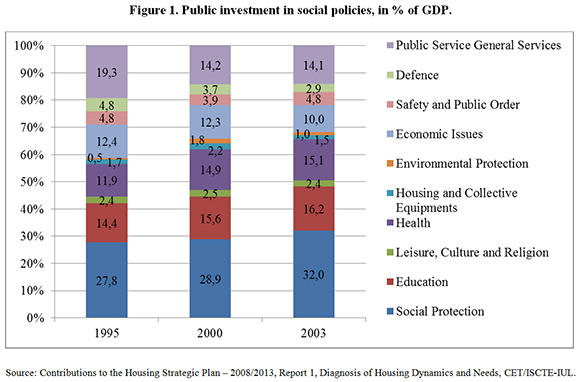
According to common knowledge, this characteristic is not exclusive to Portugal; indeed, it is a structural trend in the Southern European countries cluster (Allen et al, 2004) that experienced a late development in their welfare state, predominantly oriented towards other intervention sectors, composing, in terms of housing systems, what is known as a “residual welfare” (Guekiere, 2008; Levy-Vroelant, Tutin, 2010). These countries’ housing stock structure, in terms of promotion and occupation regime, is still reminiscent thereof, with a low percentage of social housing in the general housing stock, a fragile public renting system, reduced ratios of social dwellings, along with high homeownership rates[3] (See Fig. 2 and 3).
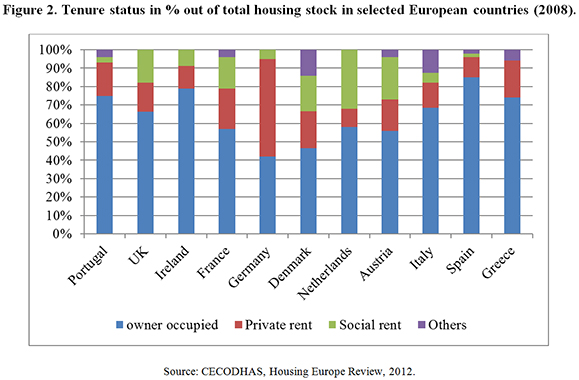
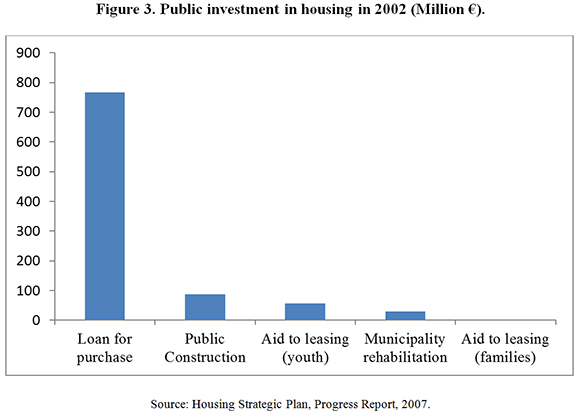
The particular feature of the Portuguese case lies on its development model, one that combined late urbanization, an immature and unfinished industrial development process, and a segmented labour market between a «secure» sector, linked to the functioning structure of the public sector, and an «insecure» sector, connected to the informal and black economy (Allen, 2010). This labour market polarization reproduces uneven capabilities in accessing housing market, rendering «natural» candidates to social housing incapable of accessing housing market while, on the other hand, privileged recipients of public investment in housing are largely aided through the support to homeownership. In the first situation, those unable to find in social housing neither enough supply to meet their needs, nor the housing model most appropriate to their residential status, have developed parallel ways to access housing, through self-construction and self-promotion, of an illegal nature, particularly important in the 1970’s (Ferreira et al,1985); the latter, although faced with a fragile public intervention in housing, were partially offset by a «familyist culture», based on a relationship system between an extended family that provides readily available means to the access to housing, adding to public aid in terms of tax and financial incentives to the access to homeownership.
We need to recognize, however, that Portuguese governments have been allocating a significant amount of funding to housing, despite the great disparity between direct public intervention (promotion of social housing) and indirect intervention (support to homeownership). In fact, during the last three decades of the twentieth century, public housing investment has been driven into two fundamental pillars: the support to homeownership, through financial (subsidized credit) and fiscal benefits and the construction of social housing, while other housing programmes and measures as rehabilitation or subsidized lease programmes for young people have a small dimension and impact (see Figure 3). Nevertheless, this trend is not specific to Portugal neither to Southern European countries, in a European context marked by a state retraction trend in terms of housing investment, a progressive transition from the «support to stone» towards the «support to the person». This trend has had consequences in homeownership rates, while there has been a growing involvement of local bodies and other actors in the promotion of social housing, progressively smaller and focussed to more vulnerable populations, making social housing policies more dissimilar to the support to social housing as a specific tenure status, defined by the public or semi-public nature of its promoters (Lévy-Vroelant and Tutin, 2010: 10).
A recent and irregular public investment
Besides the residual share of social housing (3%) when compared with other European countries (see Figure 3), Portugal has got a relatively new social housing stock. About 60% of buildings were built after 1980 and even about 24% after 2000. Although recent, Lisbon has got the oldest social housing stock: about 44% of buildings were built after 1980 while Madeira and Azores have got the newest ones: more than 50 % were built after 2000 (see Figure 4).
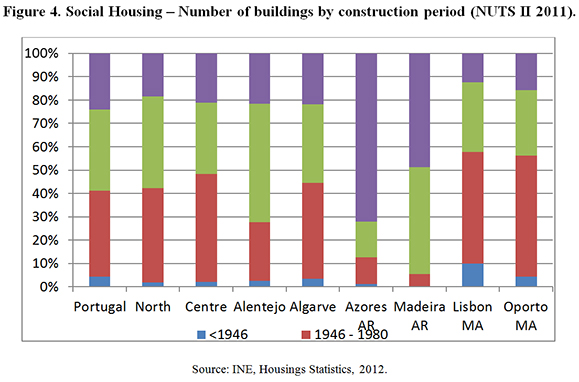
The social housing stock youth is revealing of the public disinvestment in this domain and the absence or fragility of other public or private actors in the promotion of social housing or cost-controlled housing. While public investment in social housing, prior to the 25 April Revolution, was directed towards housing for «working classes» with secure income(Batista,1999), in the last decades this investment is still fragile and quite telling of an irregular situation, lacking continuity and articulation between the several social housing promotion programmes. Faced with a major housing deficit for vulnerable groups who had previously «solved» their housing problem through informal and extremely precarious construction, PER (Special Rehousing Programme) was created, giving priority to people living in shanty towns in the major metropolitan urban areas, which turns out to polarize a great deal of social housing stocks in Portugal, concentrated in time and space (see Figure 5). Indeed, the period between 1995 and 2002 was marked by an unparalleled construction pace in terms of social housing, matching the enforcement of a great deal of the PER Programme, and weighing heavily on the average youth of this housing stock sector. Strong dependence on central public investment combined with an undefined role and competencies of the central and local administration strongly contribute to the irregularity of investment in social housing promotion.
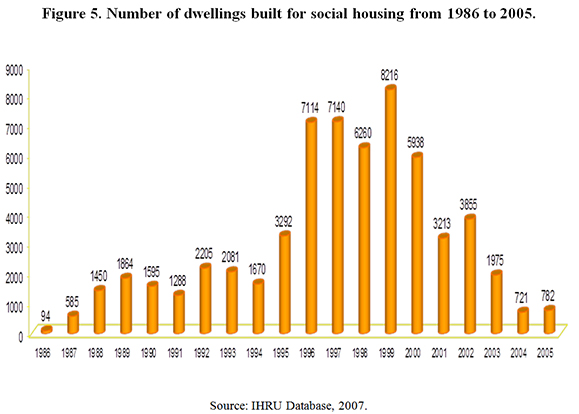
A model of concentrated location
We have already discussed the limited extent of the Portuguese public housing stock as opposed to other European countries, as well as the factors underlying this situation. In fact, it does not go beyond 3% of the general housing stock while in other countries, such as the Netherlands, it amounts up to 32%. Public housing stocks weight on the general leasing sector, although slightly higher (14,3%), is comparatively quite low when faced with figures from the Netherlands (75%) or the United Kingdom (54%). This disparity is also clear when we compare the ratio of social housing dwellings per 1000 inhabitants, with a minimum[4] of 10,9 in Spain, followed by Portugal (11,2), and a maximum of 138 in the Netherlands, and 100 in Austria (See Figure 6).
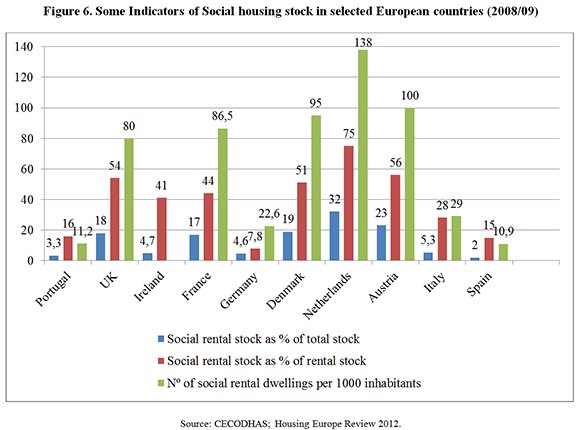
Nevertheless, the problem lies not only in the shortage of the public housing stock, which naturally limits access to housing and reduces potential diversity of its target public. Adding to this there is the specificity of the Portuguese case, intensely focusing social housing within the Lisbon and Oporto municipalities. The following charts illustrate this situation. Lisbon and Oporto have the highest percentages of social housing in the overall housing stock (11,4% and 14,3%, respectively, Figure 7), with increasing figures once we compare this weight in the overall leasing market (27,3% and 32,8%, respectively: Figure 8). The same is true when we observe the proportion of inhabitants in social housing or the ration of social housing dwellings per 1000 inhabitants.
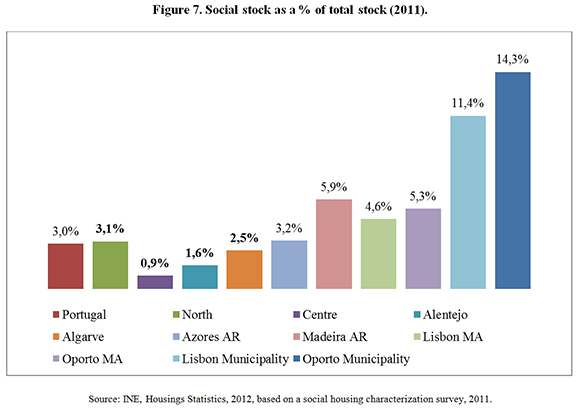
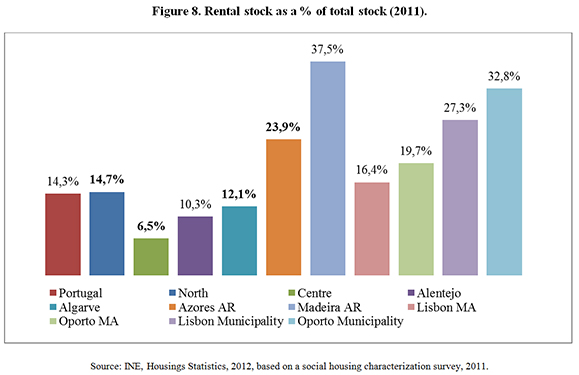
Even though only 2,8 percent of inhabitants in Portugal live in social housing, and the number of dwellings per 1000 inhabitants in this sector does not surpass 11,2%, these values are very different when we limit the focus on Lisbon and Oporto Metropolitan Areas, and still further once we zoom in on Lisbon and Oporto municipalities. Oporto municipality harbours the highest percentage of social housing population, as well as the highest ratio of social housing dwellings per 1000 inhabitants: 13,6% and 23,7% respectively (Figure 9 and Figure 10). Next, we have Lisbon, with 10,7% of its population in social housing and 18,5 social housing dwellings per 1000 inhabitants (Figure 9 and Figure 10).
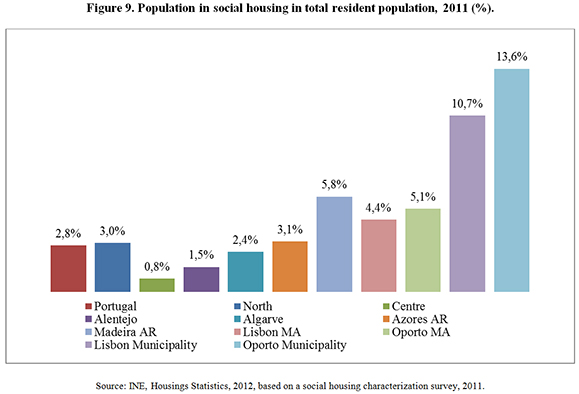
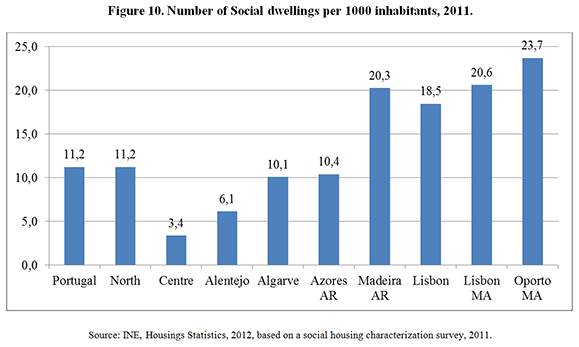
This disparity in figures, owing to a spatial concentration rationale in the two metropolitan areas, can largely be explained by the aforementioned recent construction of the social housing stock. With a great portion of construction starting after the 25 April Revolution, especially with the PER Programme, this labour sought to provide solutions to housing needs in the largest cities, which were the main destination during decades of migratory flows that inhabited them in shanty towns and illegal construction.
Meeting these needs had a paradoxal effect, however. Time pressure, the urgency to solve housing problems in those territories where they were sharpest, produced a model of spatial concentration not only within these two metropolitan areas but also within their centres (Lisbon and Oporto cities), particularly in peripheral territories, producing dense, unqualified neighbourhoods, lacking equipments and infrastructures, and often with reduced accessibility (Pinto and Gonçalves, 2000; Guerra, I, 2011). This spatial concentration model matches a social concentration rationale, of individuals with similar traits of vulnerability[5] and limited ability to break social exclusion processes that tend to reproduce themselves in new residential settings.
The combination of these time, space and social concentration processes has contributed to the increase of socio-spatial segregation processes and to the consolidation of a social housing model that projects a negative public image, stigmatizing territories and populations (Pinto e Gonçalves, 2000).
Who lives in social housing neighbourhoods? A very targeted model
Public investment in social housing, social housing stock dimension and the criteria to access this sort of housing largely determine the profile of social housing inhabitants. The «universalist» housing model, linked to Northern European countries, where social housing is accessible to almost everyone, hosts a great variety of publics and socio-demographic profiles. On the contrary, in countries such as those in Southern Europe, the «residual welfare» model narrows the entry way to this kind of housing, recruiting its inhabitants within the most vulnerable social categories, who have no other way to find homes.
Nevertheless, the evolution of housing policies, even in countries where this sector is heaviest, in a context of continuous state retraction in terms of public housing investment, has meant further homogeneity in target publics, more and more connected to the underprivileged. Also, the encouragement to homeownership has had the effect of favouring the exit of middle classes from the social housing stock, leading to diminishing social mixture, a more negative image of this sector and the polarization of incomes and tenure status, spatially translated into further segregation. The joint effect of these two processes renders the poorest, low income workers, young middle classes with meagre economic capacity, single-parent families, ethnic minorities and large families usually overrepresented in the public sector (Scanlon and Whitehead, 2010), which originates a certain specificity in the social profile of social housing beneficiaries. (See Table 1)
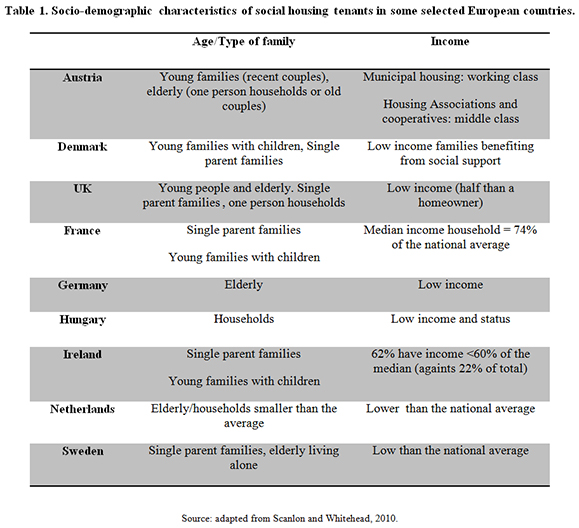
In Portugal, the scarcity of the public housing stock and a housing policy pointed towards access to homeownership condition the profile of social housing stock inhabitants from the start, recruiting its audience amongst the those who are the most? vulnerable. This bottleneck effect in the access to social housing enhances the aforementioned results of spatial concentration, reinforcing the segregated nature of these settlements . Rather than enabling the creation of relatively heterogeneous urban fabrics, composed by diverse socio-demographic categories, this social housing model strongly contributes to the polarization of groups and spaces, reproducing stigmatizing images of these locations.
An analysis of the social profile of public housing stock inhabitants[6] shows, compared to the general Lisbon population, features that shed light on the channelling of social housing towards lower resources and more vulnerable groups. Although the general population structure, in terms of age, is not as aged as Lisbons population, there are clear signs of ageing – 21,8% public housing inhabitants are over 64 years old, a possible tell-tale of a long permanence in this housing system, showing weakness in terms of residential and social mobility capacity of this population. Alongside this indicator, qualification structure is an important indicator in the degree of social integration or, conversely, of exclusion, due to the impacts of labour integration and income source and level. Indeed, survey data presented show a significant proportion of people with no education whatsoever, or with an education level below compulsory education (20,4% and 78,2%, respectively), heavily contrasting with the average education level of the Lisbon population. This qualification and age structure also weighs on the occupational structure, with low activity rates, high unemployment levels and a great proportion of retirees. (See Table 2).
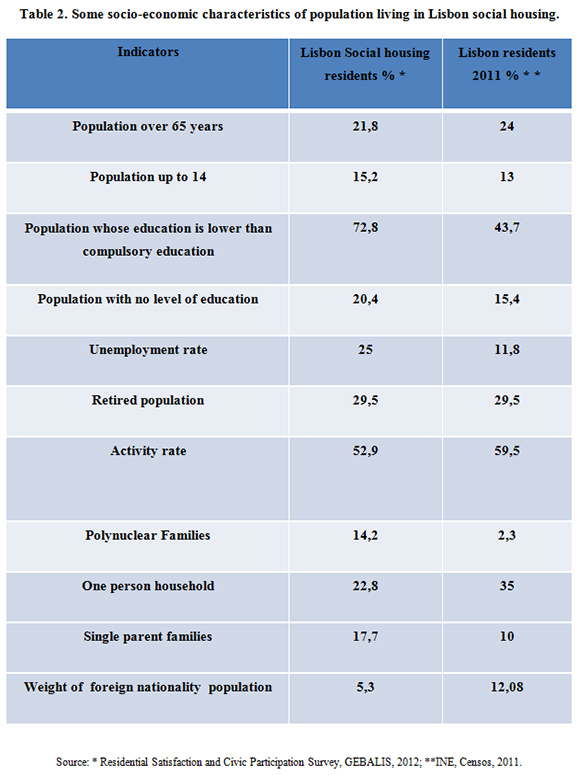
Adding to these data, a more detailed analysis of a few indicators, such as the main means of livelihood, exposes the strong degree of social dependency among this population and the frailness of income from salaried work. Figure 11 demonstrates that only 24,5% of all residents in public housing settings live off their wages, while 38,1% are under the care of their families and 37,8% rely on welfare. This situation is lined up with conditions of high risk of poverty and social exclusion. Undoubtedly, poverty risk afflicts almost 70% of those living in these neighbourhoods, particularly children, the unemployed and inactive, and those residing in newly constructed neighbourhoods (Figure 12).
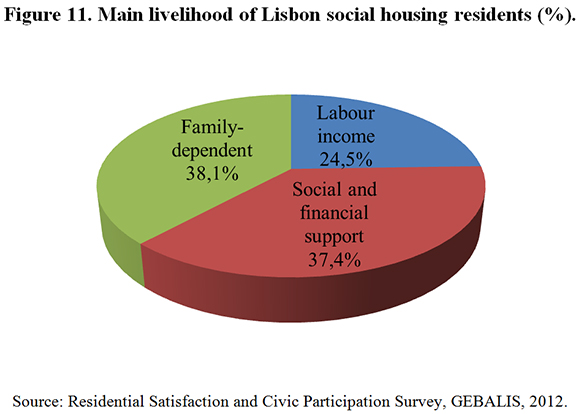
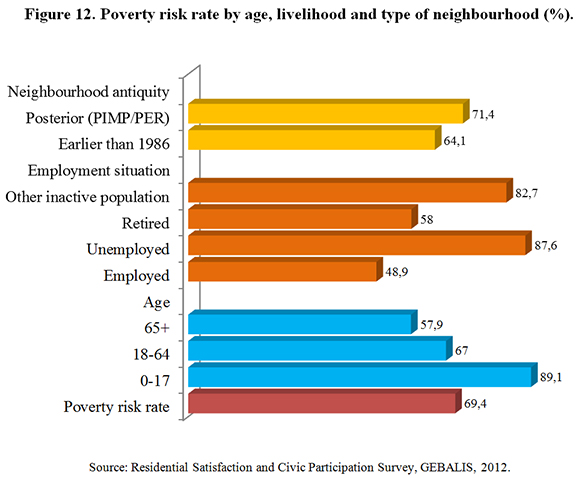
Other data complement the feebleness of this population. Departing from figures representing the Lisbon population, it is clear that precarious housing situations tend to linger within public housing inhabitants. For instance, the quota of polynuclear families (14,2% in social housing/ 2,3% in Lisbon. See Table 2), suggests overcrowding situations, or even the weight of traditionally more vulnerable kindred structures such as single-parent families (17,7% and 10%, respectively).
An interesting fact, not fully agreeing with European standards, with overrepresentation of foreign populations in social housing, is the smaller presence of non-natives in these neighbourhoods compared to the general Lisbon population (See Table 2), which might indicate their dispersion along run-down peripheries or equally degraded central areas of the city of Lisbon.
This social portraying of the social housing neighbourhoods inhabitants social profile, in Lisbon, leads us to question the function of social housing as a housing policy, as well as its accessibility. In the Portuguese case, for the past decades, the bipolarization of public investment into i) the support to homeownership; and ii) the promotion of concentrated social housing, predominantly through rental stock, has resulted in the strong limitation in the access to the latter, channelling vulnerable groups with fewer resources to this sector, closing out other sorts of population and impeding the composition of more hybrid urban tissues. This particular feature of social housing stock inhabitants contrasts with other European countries where the goals and dimension of social housing enable the creation of an affordable alternative for working families with lower salaries, steering more vulnerable populations towards other bodies, such as charitable organizations or other sectors as housing private market sector. This is the case of countries such as France, Germany or Austria, where this sector has an important role in housing the poorest (Scanlon and Whitehead, 2010).
It is chiefly the reduction and concentration of groups with similar vulnerability traits that reinforces the segregated and segregating nature of this sector, feeding «neighbourhood effects» theses that underline the reproducing and contaminating effect of socially degraded spaces that further deteriorate the statute of this population, blocking or hindering positive social mobility paths (Pinto and Gonçalves, 2000).
Subsisting important quantitative and qualitative housing needs
In spite of the limited extent of the social housing stock and its socially homogeneous profile, we notice that in the decade of 2001-2011 there have been, in general, significant improvements in housing conditions. In fact, non-conventional dwellings practically disappeared (thanks to PER – Special Rehousing Programme), while we witnessed a decrease in the number on families in shared dwellings, in dwellings without at least one of three basic infrastructures, and even a decline in overcrowded homes or integrated in very degraded buildings. (See Table 3).
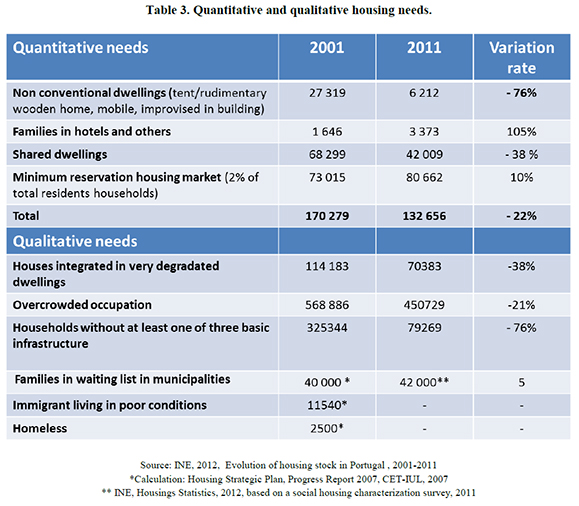
However, important quantitative and qualitative housing needs still remain, probably worsened by the current financial and economic crisis. Contrary to the trend mentioned above, Portugal maintains a worrying lack of affordable and decent homes for the most vulnerable groups: the number of families in the municipalities waiting list has been increasing, as an important number of immigrants living in poor conditions or homeless remains. Also, the number of overcrowded homes or severe housing deprivation should not be underestimated as is shown in the following table, especially when compared to some other European countries.
On the other hand, the specificities of contemporary demographic and family Portuguese structures, as in some other European countries, establish specific needs concerning housing: the decrease in family size, the growth of single-parent families, the emergence and increasing importance of new types of family, the ageing of population, all call for different residential models and ways of affordability. Likewise, profound changes in the labour market translated into more mobile and flexible work may have consequences on housing needs and ways of acceding housing .
The effects of the crisis will probably intensify housing needs and the demand for affordable homes. This breakdown, both in families capacity as in public intervention, poses a serious problem in terms of housing affordability, not only for traditionally lower income groups, but also for those who face problems of unemployment, loss of income and especially young adults, single-parent families, and the elderly.
The complexity and hardships in this context leads to inevitable interrogations on the role of the state and housing policies, namely the role of social housing as a response to wider groups than those it has traditionally been covering. This point will be further discussed next.
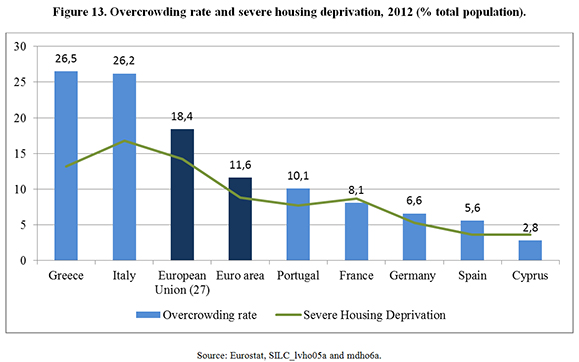
The right to housing: rethinking housing policies
The recognition that the profound transformations of societies have originated major changes in housing dynamics, linked to socio-cultural and lifestyle transformations, and the changing role of the state will be at the centre of the new «paradigm» of European thinking about the residential dynamics and the ways to intervene. The changes of society – of individuals, families, economy and organizations of the state – could not fail to have an impact on social policies as a whole, and particularly in housing policies.
Crossing the neoliberal thinking of the last decades, the debate about the balance of housing dynamics, to a large extent, went from a debate on the «right to housing» to the debate centred on the «balance between supply and demand». Although the basic objectives of a housing policy remain – dignified housing for every family at prices compatible with their incomes – the means to achieve that changed radically.
In the European context, and also in Portugal, almost all social partners agree that, these days, more than providing new housing, the essential function of the State is to support housing access to people with difficulties entering the private market, while also handling and making profitable the public housing stock that remains from the previous intervention paradigm.
In a context marked by increased demand for social housing or affordable housing, due to factors such as the increase in the number of families, immigration flows, growing income instability and inequality, making affordable housing available to more heterogeneous social groups is an mounting challenge. All the more so as the current trend, even European-wide, is for central state and municipal disinvestment towards the implication of a greater variety of actors in social housing supply, pointed to a socially more diverse public (Scanlon and Whitehead, 2010). Actually, the most common approach throughout Europe, against highly restrictive Community guidelines in terms of the social housing eligibility definition, is the overture of social housing neighbourhoods to a more heterogeneous population, becoming attractive to younger families or one-person households with lower incomes. In that sense, there have been urban requalification operations, with partial demolition of the existing stock in order to reduce the concentration of mediocre quality dwellings and disadvantaged families, bypassing social segregation rationales and a near-exclusive access of vulnerable categories (Scanlon and Whitehead, 2010).
Nowadays, in Portugal, the deep economic crisis affects not only families and their living conditions and their income, compromising ability to access the housing market, but also drastically affects public investment in social policies and especially in housing. What we have been witnessing is the complete dismissal of the central administration, either of their supply functions, or of its regulatory role. Currently, Portugal tends to follow a complete liberalization path with respect to the housing market, both by the breaking in provision of social housing or housing at controlled costs, and by producing legislation which liberalizes the rental system, and also by decreasing investment in rehabilitation programmes or subsidized rents for young and vulnerable groups, as we can see in the following figures.
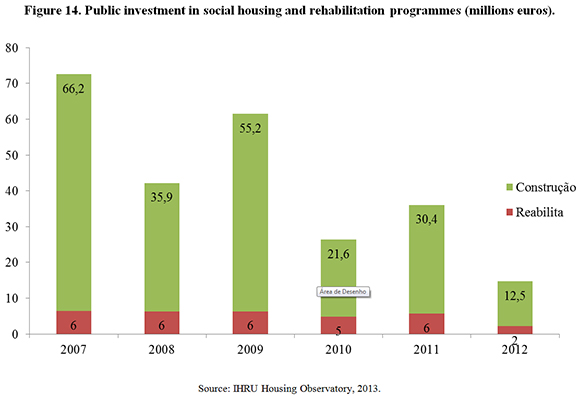
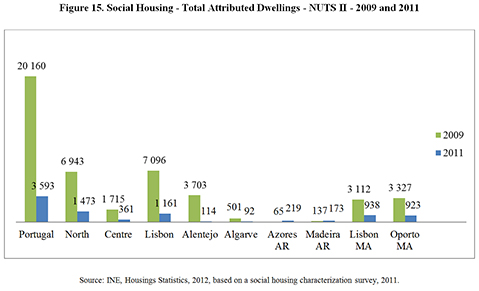
However, the public finance crisis should not lead to a decline in housing policy, as this has as major consequence, adding to the difficulties of the families in accessing housing, aggravating their living conditions, reducing economic activity and brutally destroying many jobs. Conversely, it is necessary to ensure in this crucial economic sector a better performance in terms of its role as a buffer for the general crisis.
In the specific field of housing policies, the Portuguese state, as other European instances, should move from the role as an agent providing houses to a subsidiary and regulatory one. In fact, with the crisis, the state has had less intervention in direct housing promotion, but should reinforce its regulatory and normative role. These new public functions should increasingly rely on systems of partnerships, whether with the municipalities or private entities, including the co-operative sector.
In recent years, some of the responsibilities in housing domains, as well as in urban regeneration, have been transferred to municipalities who have been taking charge of the development of Local Housing Plans, defining urban areas of priority intervention, involving individuals, enterprises and local stakeholders.
But many questions remain in this specific context of severe economic and financial constraints: what should be the role of the state? What should be the financial model, sharing resources and responsibility between state, municipalities and enterprises? How to do to reuse existing urban and housing resources? How to design programmes to support insolvent families and low-income middle classes? How to assure a more flexible and sustainable housing system?
The above changes in Portugueses society and in house dynamics are forcing us to rethink housing policies and pushing the recasting of the role of the state. On the one hand, there is the recognition of profound changes in the Portuguese society and current policies with significant impact on housing, in particular, the dynamics that arise from changes in the financial market, the lifestyles and socio-cultural needs of the people. On the other hand, the acknowledgment of persisting serious and dramatic problems of families in accessing housing.
We take on some of the most significant proposals of the Strategic Plan for Housing and Urban Renewal that wished to introduce some measures that could change the ways of designing housing policies in Portugal more in line with the new context and with the transformations of the public policies. From the point of view of the Strategic Plan, the state should strengthen the functions of planning, regulation, surveillance, monitoring and evaluation, reorganizing its role as a key partner – with local authorities, social organizations, co-operatives, private ones – for the implementation of policy measures, clarifying roles and relationships and also expectations and responsibilities.
The main guidelines for housing policies should be based on 5 pillars, levelled as follows:
1. Greater knowledge of housing needs, at regional levels, and how the local market is meeting them, identifying needs and resources;
2. Intervention on the existing housing stock, profiting from the investment already carried out and supporting the match between housing supply and demand, namely within to populations with difficulties accessing the housing market;
3. Prevalence of the support to the person vis-à-vis the support to stone and flexibility of policy measures in order to match the various types of needs, regional contexts and historical moments;
4. Redefinition of the role of the state, decentralizing functions to municipalities and maintaining its role as regulator, clarifying the regulatory measures (legislation) and stimulating the debate on innovative responses.
In addition to these basic assumptions, there were still the main axes of intervention defined as follows:
Integration of housing policies in city policies
The aim will be the shift from a model centred in the access to home to a habitat development-centred model in a process where the housing policies could refresh urban dynamics, geographical mobility associated with the development of networks and regional planning. Measures which would result of this challenge proposed the monitoring of a mixing growth of urban renewal with controlled cost housing quotas.
Using housing market surplus for socio-urban insertion of populations
It was deemed necessary to entail the transition from a polarized model, with the primacy of public intervention in the housing promotion in a single moment (support to stone), to a model organized through public-private partnerships and focusing on the segmented housing needs, at various times and in different ways (logic of response to demand). The use of housing surplus available in the market at this moment could be an indispensable heritage for diversifying policies designed both to encouraging sale, lease or purchase, and to increase the public stock.
Favouring the rental scheme either in private or public markets
Already in 2006 it seemed right to encourage the rental sector, a measure adjusted to new needs and the instability of family budgets which would require bold measures in support of leasing in the private market and the social market.
The proposal to a move from the model of public offering rehousing for life driven by relatively undifferentiated quantitative aspects (the provision of homes) to more flexible formulas that foster greater housing mobility. The support to rent could encourage social and geographic mobility and allowed the administration to hold on to a reasonable number of options for people with occasional accommodation difficulties. The model contained not only the urban integration of relocation, as the diversity of policy measures (for local public administrations and private actors) but also the encouragement for the placing on the market of rent vacant or degraded homes.
Better management of public housing park and diversification of housing funds
The Strategic Plan was primarily a social housing plan aimed at insolvent populations who had no access to the private market in itself and, in this sense, a transition from a rigid model centred on home support to a response to different social groups with different needs (for example, same medium social classes with the crises were forced to hand their properties over to the bank). This more complex and articulated answers needed a greater understanding of costs and accountability of the various housing products and of the demand of different families and necessities. The Plan suggested searching for new resources, diversifying the sources of funding and leveraging the fiscal and financial mechanisms and city policies to expand resources for provision of low-cost housing.
A regulation in partnership with local communities
The tradition of centralism of the public policies, and often conflicting with municipalities, advocates for a co-production policy with local authorities, not only in the realization of some of the axes and measures, but especially in the responsible participation of planning in their areas of jurisdiction. Proposed at the Local Housing Programmes medium-term, which would contain the hierarchy of needs, the location and types of intervention in the form of regular applications and integrating the different solutions provided for our national resources.
Some concluding remarks
The context of housing in Southern Countries has always been marked by a strong dichotomy between those that can have access to homeownership, even with state help, and those who are relegated to social housing or to illegal housing systems.
However, the growth of homeownership regimes in the past decades, in all European countries, and the discussion of this phenomenon and its connection with the growing frailness of the welfare state, is also a reference for Southern Countries, raising new and important questions.
Although it is true that in the Southern European regime family plays a very important role in providing welfare, a source of aid where home takes on a particular status and plays a particular role in transfers and exchanges of wealth between generations (see Allen et al, 2004), it is also true that the welfare state provides incipient support. We can hypothesize that, in these countries, the high rate of property is less a ideological question, as it is so frequently stated, than a matter of research for life stability in societies where the predominance of informal sectors of the economy with instable salaries, a low wage formal sector and a weak welfare protection dictate the search for more stable living conditions.
In fact, more and more researchers are discussing how homeownership has potentially significant consequences for welfare state policy. High owner-occupancy rates may function as private insurance where social spending is low and may function at a less pressing level on wage. Cross-national time-series data show that social spending is negatively related to home ownership, and mediates the positive relationship between income inequality and owner-occupancy rates. This suggests that owner-occupancy acts as a form of social insurance over the life course. Future welfare state researchers should consider the issue of home ownership in analyses of inequality and the social safety net. (Conley and Brian Gifford, 2006)
According to Richard Ronald (2012), on the effects of the current crisis on families lives, even in European developed countries the uptake of owner-occupied housing and the advance of property markets, making households both more open and capable of self-provision, is clearly well-established. Home ownership in many contexts has not only represented neo-liberal ideology, but has also been effective in eroding public housing systems as a material and symbolic basis for the welfare state (Forrest and Murie, 1988).
In those countries where welfare state is not very strong, as Portugal, crises diminish most public social policies and especially housing policies. Even more so, this crisis hinders many families earnings, not only the underprivileged but also middle classes under great stress in order to keep their homes, purchased when their income wasnt threatened and professional and housing paths of continuity could be depended upon.
Generally, in the last decade housing policies have been deeply transformed by the societal changes caused by globalization phenomena, economic crisis, deep cultural and demographic transformations, emerging new needs and new challenges. Although there is not a clear picture of all the complex relationships between these changes and the new housing issues, there is some consensus among policymakers and academics over the fact that the old answers and models are no longer appropriate. As stated by Houard (2011), in most European countries, crisis seems to have enhanced the vicious effects of previous housing policies, and especially showed the limits of homeownership extension and the need to maintain or increase affordable social housing supply, one that is balanced and adapted to territorial necessities (Houard, N., 2011:17). The question now is how the production of low-cost housing for specific social groups will be assured (and not only for the poorest ones), where and how is possible to draw the borders of a clear distinction between private market and public housing policies (and other social policies), or even the sense of the continual promotion of homeownership.
Consequently, at least in Portugal, it is determinant, both for the state and families, to rethink housing solutions towards an intervention bounded by the crisis, effective in the short- and middle run. Clearly important is the existence of institutional solidarity between the state, families and markets, so that all share part of the hardship. These new policies should reorder relationships and obligations between citizens, market and the state. In the new model, autonomy and responsibility must be an obligation for all partners and provide an innovative focus-oriented solution to the diversity of needs and incomes, paired with social justice and a fair partition of ever-scarce resources.
Such transformations compel us to rethink housing policies in times of change, the institutions that were entrusted with implementing them, financing models and target groups. But we must also accept that some questions remain immutable and these are related to the recognition that a significant proportion of the population of European countries, notably in Portugal, has not yet solved their housing problems. And, in this sense, perhaps the question of housing has not changed as much as it might seem, at least in countries with fragile intervention in the past century.
REFERENCES
Allen, J. ( 2010), Pays du Sud au risque de la propriété » in Lévy-Vroelant, C.; Tutin, C. (2010), Le logement social en Europe, Paris, Presses Universitaires de Rennes, pp 79-94.
Allen, J. et al (2004), Housing and Welfare in Southern Europe, Oxford, Blackwell. [ Links ]
Baptista, L. (1999), Cidade e Habitação Social, Oeiras, Celta Editora. [ Links ]
CECODHAS, (2012), Housing Europe Review, 2012. The nuts and bolts of European social housing systems, Brussels, CECODHAS Housing Europes Observatory. [ Links ]
Centro de Estudos Territoriais (2007), Relatório de Progresso de Contributos para o Plano Estratégico de Habitação, CET-IUL. [ Links ]
Centro de Estudos Territoriais (2007), Plano Estratégico de Habitação, 2008-2013, Lisboa, CET-IUL. [ Links ]
Conley and Gifford, B. (2006), Home Ownership, Social Insurance, and the Welfare State, Sociological Forum, Vol. 21, No. 1, March 2006 (C 2006) DOI: 10.1007/s11206-006-9003-9. [ Links ]
European Commission (2011), "EU Employment and Social Situation Quarterly review", January 2011. [ Links ]
European Commission, Eurostat (2012), SILC. [ Links ]
Ferreira, F. et al. (1985), Perfil Social e Estratégias dos Clandestinos. Estudo Sociológico da Habitação na Área Metropolitana de Lisboa, Lisboa, CIES/ISCTE. [ Links ]
Forrest, R. and Murie, A. (1988), Selling the Welfare state: the privatization of public housing, London, Routledge.
Guekiere, L. (2008), Le développement du logement social dans lUnion européenne », Recherches et Prévisions, nº 94, Dez 2008, p.21-34.
Guerra, I, (1994), As pessoas não são coisas que se ponham em gavetas, Sociedade e Território, n.º 20, Afrontamento. [ Links ]
Guerra, I. (2011), As Politicas de habitação em Portugal: à procura de novos caminhos, CIDADES, Comunidades e Territórios, n.º 22, DINAMIACET-IUL. [ Links ]
Houard, N., (coord.) (2011), Loger lEurope. Le logement social dans tous ses États, Paris, La Documentation Française. [ Links ]
IHRU (2013), Observatório da Habitação. [ Links ]
INE (1991, 2011), Censos. [ Links ]
INE (2012), Evolução do Parque Habitacional em Portugal, 2001-2011. [ Links ]
INE (2012), 2011, Estatísticas da Habitação e Construção. [ Links ]
INE (2013), O Parque Habitacional e a sua Reabilitação. Análise e Evolução 2001-2011. [ Links ]
Lévy-Vroelant, C. et Tutin, C., (Dir.) (2010), Le logement social en Europe, Paris, Presses Universitaires de Rennes.
Lévy-Vroelant, C. et Tutin, C. (2010), « Introduction : État-Providence et logement social, ou lintrouvable modèle social européen » in Lévy-Vroelant, C. et Tutin, C. (Dir.), Le logement social en Europe, Paris, Presses Universitaires de Rennes, pp 9-16.
Malpass, P. (2011), « Privatisation et logement social au Royaume-Uni » in Houard, N. (coord.), Loger lEurope. Le logement social dans tous ses États, Paris, La Documentation Française, pp. 21-35. [ Links ]
OECD (2011), Divided We Stand: Why inequality keeps rising, [ Links ] December 2011.
OECD, (2011), Housing Markets and Structural Policies in OECD Countries, OECD Economics Department Working Paper No. 863. [ Links ]
Pinto, T.C. e Gonçalves, A. (2000) “Os Bairros Sociais vistos por si mesmos: Imagens, Conflitualidades e Insegurança”, CIDADES. Comunidades e Territórios, nº1, CET/ISCTE.
RICS, (2011), The Housing Sector - Household Consumption from a European Perspective. [ Links ]
Richard, R. (2012), How Housing Markets Changed the World: Family Property Wealth and the New Welfare State, Amsterdam, University of Amsterdam. [ Links ]
Scanlon, K., Whitehead, C. (2010), « Le logement social en Europe: tendences communes et diversités persistentes » in Lévy-Vroelant, C., Tutin, C. (Dir.), Le logement social en Europe, Paris, Presses Universitaires de Rennes, pp. 18-44. [ Links ]
Notes
[3] The occupation structure of the housing stock in the European context does not currently reflect the public investment that was allocated to housing promotion in past decades, due to the process of public housing stock alienation and sale to former tenants, taking place in many countries. Noteworthy cases include the United Kingdom and Ireland, with much higher homeownership rates at the moment. (Malppass, 2011; Redmond, Wassenberg, 2010).
[4] Among analysed countries.
[5] See next point in this article.
[6] This analysis in based on the results of a survey about Residential Satisfaction and Civic Participation carried out in Lisbon by GEBALIS (municipal enterprise who manage social housing park) in 2012. Sample: 1004 surveys in 20401 households in lease agreement with GEBALIS. Data are courtesy of Gebalis.














